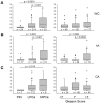Nuclear MTA1 overexpression is associated with aggressive prostate cancer, recurrence and metastasis in African Americans
- PMID: 23900262
- PMCID: PMC3728596
- DOI: 10.1038/srep02331
Nuclear MTA1 overexpression is associated with aggressive prostate cancer, recurrence and metastasis in African Americans
Abstract
Metastasis-associated protein 1 (MTA1), a negative epigenetic modifier, plays a critical role in prostate cancer (PCa) progression. We hypothesized that MTA1 overexpression in primary tumor tissues can predict PCa aggressiveness and metastasis. Immunohistochemical staining of MTA1 was done on archival PCa specimens from University of Mississippi Medical Center and University of Iowa. We found that nuclear MTA1 overexpression was positively correlated with the severity of disease progression reaching its highest levels in metastatic PCa. Nuclear MTA1 overexpression was significantly associated with Gleason > 7 tumors in African Americans but not in Caucasians. It was also a predictor of recurrent disease. We concluded that MTA1 nuclear overexpression may be a prognostic indicator and a future therapeutic target for aggressive PCa in African American men. Our findings may be useful for categorizing African American patients with a higher probability of recurrent disease and metastasis from those who are likely to remain metastasis-free.
Figures




References
-
- Tollefson M. K., Karnes R. J., Rangel L. J., Bergstralh E. J. & Boorjian S. A. The impact of clinical stage on prostate cancer survival following radical prostatectomy. J. Urol. 189, 707–712 (2013). - PubMed
-
- Salonia A. et al. Preoperative sex steroids are significant predictors of early biochemical recurrence after radical prostatectomy. World J. Urol. 31, 275–280 (2013). - PubMed
Publication types
MeSH terms
Substances
LinkOut - more resources
Full Text Sources
Other Literature Sources
Medical
Research Materials
Miscellaneous

